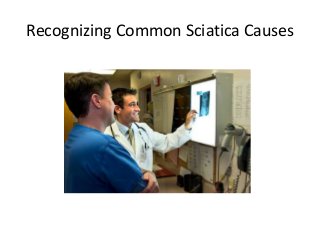
Sciatica Causes
- 1. Recognizing Common Sciatica Causes
- 2. As just about anyone suffering from the condition knows all too well, sciatica causes a variety of extremely frustrating, and occasionally debilitating, symptoms. In order to effectively treat these symptoms, however, it is incredibly important that you turn to a medical professional to develop a comprehensive treatment plan that gives you the best chance of overcoming your condition. The wrong approach may prove completely ineffective and a waste of time, or worse, it might make your symptoms increase.
- 3. What is Sciatica? Before we can discuss how to manage sciatica, it is important to understand what this condition actually entails. For starters, sciatica isn’t a condition itself, per se, but a collection of symptoms that may arise as a result of the compression of the sciatic nerve in the lower back (lumbar spine). The sciatic nerve is the longest and thickest nerve in the body. This nerve horsetails off the spinal cord in the lower back and extends down through the buttocks, hips, and legs, before culminating near the toes. In short, the sciatic nerve is extremely important because it is instrumental in our ability to walk upright. The problem, however, is that sciatica is extremely common as a result of either damage or deterioration to the lumbar spinal anatomy.
- 4. Causes of Sciatica Over the years, the anatomical elements that support the spinal column gradually deteriorate. This wear and tear is extremely normal and an unavoidable part of the natural aging process. The vertebral joints that connect adjacent vertebrae can become arthritic; the intervertebral discs that cushion and support vertebrae may become worn and ruptured; muscle can weaken; ligaments could calcify, and other problems might arise. The lower back is one of the most common places for problems to develop because the lumbar spine is both highly flexible and also supports a significant portion of the body’s weight. As a result, degenerative spine conditions are particularly common in the lower back, which can directly lead to the compression of the sciatic nerve and causes sciatica in the lower extremities. Here are just a few of the conditions that can cause sciatica: • Herniated discs • Bulging discs • Facet disease • Spondylolisthesis • Spondylosis
- 5. Initial Treatment Options One piece of good news when it comes to sciatica is that in most cases, symptoms can normally be managed effectively with a tailored regimen of noninvasive techniques. These treatments are designed to alleviate strain on the lower back and allow the sciatic compression to gradually abate. The use of low-impact exercises, stretching techniques, heat packs, ice, and nonsteroidal anti-inflammatory drugs are particularly popular. In some instances, lifestyle changes may also be recommended to complement treatment. For instance, losing weight can be an effective treatment method because the weight of carrying around excess body fat can put undue burden on the spine and exacerbate discomfort.
- 6. Surgery While conservative means are usually effective for most people, in the event that sciatica causes discomfort that does not respond to noninvasive treatment, surgical decompression may be considered. The goal of this type of treatment is to physically remove the source of the sciatic nerve constriction and also ensure that spinal stability is maintained. Historically, spinal fusion was the only real option in this instance. This type of procedure entails the opening of the spinal column in order to remove the intervertebral disc and fuse adjacent vertebrae together. The problem with open spine surgery, however, is that it is major surgery that requires hospitalization, extensive rehabilitation, and puts the patient at risk for post-operative complications, such as infection and scar tissue formation. In recent years, advances in endoscopic technology have made minimally invasive spine procedures a new, compelling option for some patients. These procedures can usually be completed through a very small incision through which surgeons gently push aside soft tissue (rather than cutting it), which greatly shortens the recovery time. In fact, endoscopic procedures are normally conducted on an outpatient basis. Each type of treatment has its own unique advantages and limitations, so it pays to explore your options, learn more about sciatica causes, and speak with several doctors before consenting to any one treatment.